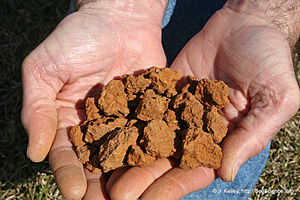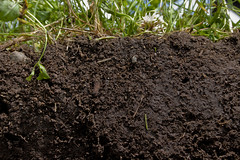Good soil consist of clay, silt and sand particles which must be present in equal parts, along with five to ten percent of organic matter.
(Photo credit: Wikipedia) |
Planting in the right soil can make the difference in whether your plants thrive or die. Good soil consist of clay, silt and sand particles which must be present in equal parts, along with five to ten percent of organic matter.
The easy way of testing what soil type you have is to grab a handful of soil and squeeze it in the palm of your hand.
- If it holds together in a firm shape and feel sticky your soil is clay. Another indication that you have clay soil is that after a good rain your ground is waterlogged, but after a few days of dry weather your ground is hard and cracked.
- If the soil does not hold its shape, crumbles and feels gritty your soil is sandy. If you have sandy soil you will notice that your water drainage is good, but it does not retain its moisture for any long period of time.
- If the soil does not hold its shape, crumbles and feels slippery your soil is silt. This type of soil needs heavy watering (or a heavy downpour) for it to retain any moisture for any length of time.
- If it holds together, but breaks apart easily, you are lucky enough to have loamy soil. Loamy soil is the ideal soil as it has the right combination of clay, sand and silt and will not only retain moisture, but will also retain its nutrients so your plants will thrive.
| Example soil horizons. a) top soil and colluvium b) mature residual soil c) young residual soil d) weathered rock. (Photo credit: Wikipedia) |
If you want to know about soil type, pH levels, lime requirements, total organic matter, and the amount of phosphates and potassium, you will need to either purchase a home testing kit or contact your local county agricultural extension service, or commercial testing laboratory. Although most gardeners do not worry about the pH in their soil, it is something to consider if you are having trouble growing certain plants. Too high or too low pH can make a difference in how a plants roots absorb nutrients, 5.5 or lower is considered strongly acidic, while 7.0 or above is considered alkaline. Therefore, the best soil pH is between 6.0 and 6.8.
You can amend your soil if it is to acidic by adding ground limestone in the fall; in the form of calcitic or dolomitic limestone, as it takes a few months for it to break down and change the pH levels in your soil. To amend soil that is to alkaline you use ferrous sulfate in the fall.
| See what healthy soil looks like (Photo credit: NRCS Soil Health) |
One of the best things you can do for your soil and your plants is to add organic matter. Organic matter can be compost, leaf mulch, manure, humus or your basic garden fertilizer that you can purchase at your garden center. By adding organic matter, you increase air circulation and water retention and thereby increase the nutrients that are needed for your plants to thrive. Because organic matter decomposes, you must amend your soil each year, no matter what type of soil you have.




No comments:
Post a Comment